BSc 2nd Year Microbiology of Soil Notes Study Material
BSc 2nd Year Microbiology of Soil Notes Study Material: BSc is a three-year program in most universities. Some of the universities also offer BSc Honours. After getting enrolled for BSc, there are certain things you require the most to get better grades/marks in BSc. Out of those, there are BSc 2nd Year Notes Study Material, BSc Sample Model Practice Mock Question Answer Papers along with BSc Previous Year Papers. At gurujistudy.com you can easily get all these study materials and notes for free. Here in this post, we are happy to provide you with BSc 2nd Year Microbiology of Soil Notes Study Material.

BSc 2nd Year Microbiology of Soil Notes Study Material
Microbial biogeochemical cycling activities and interactions between microbial populations have a direct and major influence on agriculture. A controlled balance of microbial activities is important for success in agriculture. Such activities in the soil become very important. Soil is the natural habitat for all organisms and this is a centre of important ecological processes. The addition of fertilisers and pesticides to soil makes the study of its microbiology even more important. (BSc 2nd Year Microbiology of Soil Notes Study Material)
Soil Habitats (Lithosphere)
Soil constitutes the major habitat of terrestrial microorganisms. Soil is a favourable habitat for microbes. A higher number occurs in the organically rich surface layers than in the underlying mineral soils. Particularly high numbers of microbes occur in association with plant roots as shown below.

Fungal populations are favoured in soils of low pH, and bacteria tend to occur in higher numbers in those of higher pH.
Soils have many different microhabitats. A higher proportion of Gram-positive bacteria are found in soil than in freshwater and marine habitats.
Many different genera of bacteria are commonly found in soil, actinomycetes comprising a significant proportion of the bacterial community (see below).
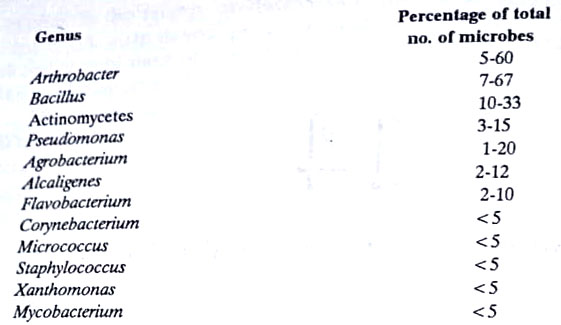
Fungi constitute the major proportion of the microbial biomass in soils. Fungi occur as free-living or associated with plant roots. The most common soil fungi are Fungi Imperfecti, but numerous Ascomycetes and Basidiomycetes also occur. Most soil fungi are opportunistic and active under favourable conditions. Many soil fungi are able to degrade polysaccharides such as cellulose, hemicellulose and a few also lignin. Organic matter in soil is largely composed of humus. (BSc 2nd Year Microbiology of Soil Notes Study Material)
Microbes in soil are responsible for biodegradation and mineral cycling. Important plant polymers such as cellulose and lignin are degraded exclusively by soil microbes. Since carbon and nitrogen are the chief macroelements essential for all organisms, soil microbes play an important role in the cycling of these elements in the biosphere. (BSc Microbiology of Soil Notes Study Material)
Microbial Biogeochemical Cycling
Microbial biogeochemical cycling activities are extremely important for the maintenance of soil fertility, that is the ability of soil to support plant growth. Because of their ubiquitous distribution and diverse enzymatic activities, microbes play a major role in biogeochemical cycling. The major elements of live biomass, carbon, hydrogen, oxygen, nitrogen, phosphorus and sulphur are most intensively cycled by microbes.
Carbon cycle
Carbon is actively cycled between inorganic CO2 and the variety of organic compounds that compose living organisms and their dead organic matter.
This cycle primarily involves the transfer of CO2 and organic carbon between the atmosphere, where carbon occurs principally as inorganic CO2, and the hydrosphere and lithosphere. Autotrophs (photo – as well as chemolithotrophs) are responsible for primary production i.e. conversion of CO2 to organic carbon. Once carbon is fixed (reduced) into organic compounds, it can be transferred from one organism to another, supporting a variety of heterotrophs. The respiration of live organisms and the degradation of organic matter, mostly in soil bring CO2 back to the atmosphere. (BSc 2nd Year Microbiology of Soil Notes Study Material)
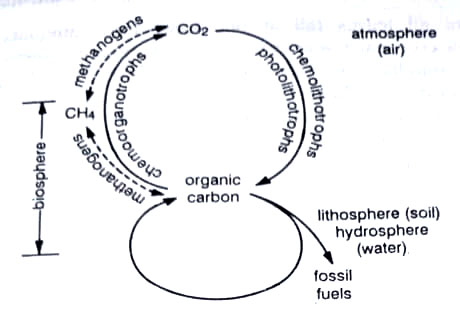
Organic matter in soil is the chief source of nutrients for plants. Moreover, these are the microbes which transform this organic carbon into various nutrients. The decomposition of organic matter by microbes is a central step in the carbon cycle. We would elaborate on this subject here.
Organic matter (humus) in soil. Organic matter is the chief source of the return of minerals to the soil. It has also a much water holding capacity. It can hold minerals as ions by absorption and binds clay particles into aggregates. It makes clay soils porous thus increasing the aeration of the soil and also causing easy percolation of water in the soil. (BSc Microbiology of Soil Notes Study Material)
Nature of soil organic matter. Soil organic matter represents the equilibrium between input, originating from primary photosynthetic production, and the degradative and synthetic processes associated with soil organisms. The input is large of carbohydrates, lignin compounds, fats and proteins with smaller quantities of free amino acids, alkanes, terpenoids, carotenoids, flavonoids, alkaloids, polyphenols, resins etc.
Most of these, such as carbohydrates, cellulose etc. are easily decomposed and have a short residence time in soil. Soluble sugars, lipids, proteins, amino acids, organic acids etc. are minor constituents of organic matter. However, the major constituents of humus are humic complexes, which make up the greatest proportion of it in most soils. They comprise a mixture of diverse phenolic polymers like lignin, resins etc.
Sources and rates of production of organic matter. Organic matter to soil is contributed by surface-living plants and animals (dead leaves, twigs, branches of plants and bodies of animals) as well as by micro-and macro-organisms living in the soil (a variety of microorganisms and animals and dead roots of plants etc.). In thick forests, each season there accumulates thousands of tons of litter on the soil surface. All dead, fresh organic matter fallen recently to the ground is called litter. In deciduous forests, where all leaves fall at one time, large amounts of litter are produced as a crop each year, whereas in evergreen forests the leaf falls gradual with simultaneous decomposition.
Thus litter here is less pronounced. In grassland, however, there is little accumulation of litter as compared with the forests. This is due to marked differences in the types of vegetation in the two habitats. Just beneath the fresh litter, there may be present material derived from the litter of the previous season in which decomposition might have progressed.
This partially decomposed litter is called duff. Thus initial input of organic matter is in the form of surface litter and underground dead root matter. But as a result of various processes, chiefly activities of microorganisms in the soil, this organic matter (litter) is grossly modified, which is now known as humus, or soil organic matter in current practice. Humus is dark, finely divided, amorphous organic matter.
Formation of humus. In humus formation, the first step is the comminution and transport of the original plant fragments by the soil fauna. After this initial breakdown, commenced by the soil fauna, microorganisms attack (bacteria, fungi, actinomycetes) increases rapidly and the original material is soon cleared of its labile components like soluble sugars, polysaccharides, proteins and fats, leaving a residue of more resistant lignin and lignin-derivatives. Thus in many soils, a large proportion of humus is derived from the joint activity of the soil fauna and microorganisms. (BSc 2nd Year Microbiology of Soil Notes Study Material)
The nature of the organic matter is governed both by input and by “soil metabolism”. Consequently vegetation, climate, parent material and topography all have a strong influence. The composition of the organic matter of soil is thus determined not only by litter chemistry but also influenced by the nature of microbiological resynthesis. The rate of humus formation and its accumulation are thus governed by the nature of microorganisms in decomposition, temperature, moisture, aeration and pH of soil. (BSc Microbiology of Soil Notes Study Material)
Decomposition of organic matter in the soil
Fungi along with other microbes, chiefly bacteria (including actinomycetes) play a vital role in the decomposition of organic matter in the soil, thus releasing the nutrients locked up in the dead organic matter of plant, animal and microbial matter and bringing about the recycling of nutrients in nature. In soil, microbes oxidise organic carbon to CO2 and liberate bound materials. The decomposition process actually begins while the plants are still intact in their environments i.e. at the senescent stage and this continues till plant remains are totally decomposed. (BSc 2nd Year Microbiology of Soil Notes Study Material)
The microbes appearing at different stages differ in their species – composition and are in fact nutritional or ecological groups of microbes. The sequence of the appearance of microbes on decaying plant remains and in the soil has been worked out mostly for fungi.
It has been shown that the primary colonisers on senescent plant parts are likely to be weak parasites and/or saprophytes of the sugar fungi group (Mucorales).
On dead tissues, the ascomycetes and their imperfect forms (cellulose decomposers) are the secondary colonisers. At this stage, some Mucorales may also appear as secondary saprophytic sugar fungi. Finally, the basidiomycetes (lignin decomposers) appear in the succession. The chemical makeup of the substrates determines the qualitative features of fungal flora appearing at a particular stage of succession. This scheme is shown below:
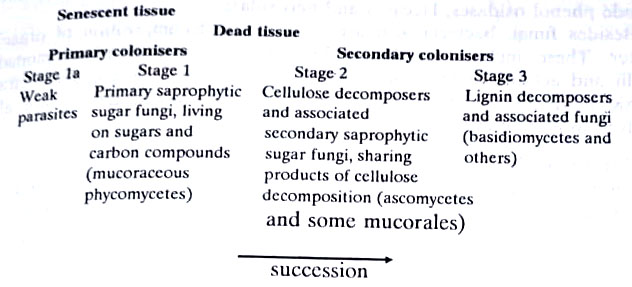
Microbes, such as fungi and bacteria (including actinomycetes) play a vital role in the formation of brown or black organic complexes which remain in a dynamic stage, through the decomposition of organic materials and through the synthesis of substances that also become part of the hummus. Humus is sparingly soluble in water but is rendered into solution by alkali.
It contains amino acids, purines, pyrimidines, aromatics, uronic acids, amino sugars, pentose and hexose sugars, sugar alcohols, methyl sugars, aliphatic acids etc. Humus is the finally broken down amorphous state of dead organic matter. In humus formation, microbes attack and degrade plant and animal remains. The plant residues comprise chiefly cellulose, hemicellulose, pectic substances and lignin.
Cellulose decomposing fungi include chiefly ascomycetes and Deuteromycetes. These are chiefly species of the genera, Aspergillus, Penicillium, Chaetomium, Trichoderma, Fusarium, Stachybotrys, Memnoniella, Humicola, Phoma, Cladosporium, Alternaria, Acremonium, Myrothecium, Thielavia etc. They have strong cellulose synthesising machinery, which breakdown cellulose to simple sugars. Three types of hemicellulases are involved in the degradation of hemicelluloses. These are endo-enzymes, exo-enzymes and glycosidases.
The fungi involved in their breakdown belong to all major groups. The most important ones are species of Alternaria, Aspergillus, Chaetomium, Fusarium, Glomerella, Penicillium and Trichoderma. (BSc 2nd Year Microbiology of Soil Notes Study Material)
Pectic substances, the primary constituents of the middle lamella and primary cell wall are broken down also by microbial pectinases. Pectinases belong to three major categories (i) hydrolytic that carry out hydrolytic cleavage of the pectin polymers (ii) transeliminases that bring about transeliminative cleavage of glycosidic links by the action of lyases, and (iii) pectinesterases which hydrolyse the methoxyl groups of the pectins, converting them to pectinic acids. Pectinases are produced by various species of Rhizopus, Aspergillus, Penicillium, Monilia, Fusarium, Rhizoctonia, Geotrichum etc. (BSc 2nd Year Microbiology of Soil Notes Study Material)
Lignin, chiefly in woody parts is degraded by basidiomycetes, such as aphyllophorales and Agaricales. Lignolytic enzymes of these microbes include phenol oxidases, laccases and peroxidases. (BSc 2nd Year Microbiology of Soil Notes Study Material)
Besides fungi, bacteria also are involved in the decomposition of organic matter. These include mostly aerobic bacteria, such as pseudomonads, bacilli and actinomycetes. Some anaerobic bacteria, including the characteristic methanogenic bacteria, growing in primitive conditions are also involved in the carbon cycle of nature. (BSc 2nd Year Microbiology of Soil Notes Study Material)
Nitrogen cycle
The nutrient in most limited supply in soil is normally nitrogen, and thus the concentration of fixed forms of nitrogen in soil usually determines the potential productivity of an agricultural field. Different chemical forms and key processes in the biogeochemical cycling of nitrogen (nitrogen fixation, ammonification, nitrification, denitrification and nitrite ammonification) are shown in Figure. The critical steps of nitrogen fixation, nitrification and denitrification are all mediated by bacteria.
Nitrogen Fixation
Whereas carbon, hydrogen and oxygen are actively cycled by microbes, plants and animals, the biogeochemical cycling of nitrogen is largely dependent on microbes. Nitrogen fixation, the conversion of N2 to ammonia or organic nitrogen, is restricted almost exclusively to a limited number of bacterial species. Few microbes and no plants or animals are able to use atmospheric nitrogen directly: plants, animals and most microbes depend on the availability of fixed forms of nitrogen for incorporation into their cellular biomass.
Other than one exceptional case, where a green alga apparently fixes atmospheric nitrogen, the process is carried out strictly by bacteria. It is estimated that microbes the world over convert about 200 million metric tons of nitrogen to fixed forms of nitrogen every year compared to about 30 million metric tons produced by industrial plants as nitrogen fertilisers.
Ammonia is the first detectable product of nitrogen fixation. It is assimilated into amino acids and subsequently synthesised into proteins and nucleic acids. Proteins, amino acids, and inorganic ammonium ions are used as a nitrogen source by many organisms that are unable to assimilate atmospheric nitrogen directly. (BSc 2nd Year Microbiology of Soil Notes Study Material)
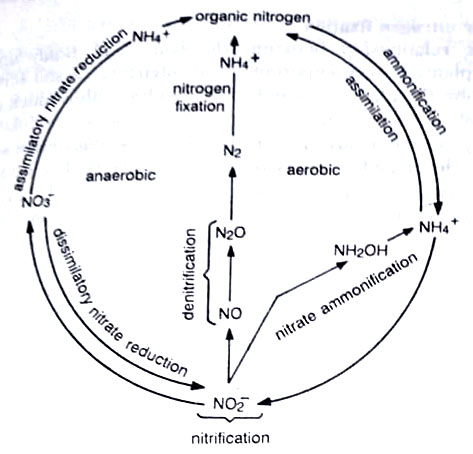
The fixation of atmospheric nitrogen depends on the nitrogenase enzyme system, composed of nitrogenase and nitrogenase reductase. The active site of nitrogenase, where reduction of nitrogen actually occurs, is associated with molybdenum- and iron-containing cofactors. Nitrogenase is very sensitive to O2 and is irreversibly inactivated upon exposure to even low concentrations. In root nodules, the enzymes are protected by red pigment leghemoglobin. The fixation of atmospheric nitrogen requires a high energy input (approx. 30 ATP/N2 fixed) and in terrestrial ecosystems largely dependent on the availability of relatively high levels of organic matter for use in the respiratory generation of ATP.
Nitrogen fixation in soil
In soil, microbial fixation of atmospheric nitrogen is carried out by free-living bacteria (a symbiotic) and those in symbiotic association with plants (symbiotic). In agricultural soils, symbiotic nitrogen fixation by Rhizobium or Bradyrhizobium is most important, where these bacteria live in association with legume crops only. In forests, other symbiotic N-fixing bacteria including actinomycetes live in association with various trees. (BSc 2nd Year Microbiology of Soil Notes Study Material)
The rate of N-fixation by Rhizobium and Bradyrhizobium is 2-3 times more than Azotobacter, a free-living N-fixing bacterium. Free-living N-fixing members of the genera Azotobacter, Azomonas and Derxia are common in temperate regions in neutral or alkaline soils. They are sensitive to low pH. In the tropics, Beijerinckia spp, more acid tolerant are prevalent in soil. The ability of microbes to fix nitrogen is readily detected by the acetylene reduction assay. (BSc 2nd Year Microbiology of Soil Notes Study Material)
In aquatic habitats, cyanobacteria, such as Nostoc and Anabaena are important N-fixers. In these microbes, nitrogenase is protected by thick-walled heterocysts where oxygenic photosynthesis does not occur. Rates of nitrogen fixation by cyanobacteria are 10 times higher than those of other free-living bacteria. (BSc 2nd Year Microbiology of Soil Notes Study Material)
Symbiotic nitrogen fixation
The symbiotic relationship between Rhizobium and Bradyrhizobium and leguminous plants is very important in the maintenance of soil fertility. These bacteria involve the plant roots and form nodules, within which atmospheric nitrogen fixation takes place. Bradyrhizobium species nodulate soybeans, lupines, cowpeas and a variety of tropical legumes. Rhizobium spp inoculates alfalfa, peas, clover and a variety of temperate plants. (BSc 2nd Year Microbiology of Soil Notes Study Material)
The establishment of an association between them and plants is very specific, and there is a mutual recognition between the bacterium and binding sites on the plant root surface. (BSc 2nd Year Microbiology of Soil Notes Study Material)
The interaction between these microbes and plant involves (i) attraction of bacteria by amino acids secreted by the root, (ii) binding of the bacteria to receptors (lectins) on the root, (iii) the activity of plant growth substances, leading to curling and branching of rootlets, (iv) entry of bacteria into root hairs, (v) development of an infection thread, (vi) transformation of plant cells to form tumorous growth, (vii) multiplication of bacteria within the nodule and, (viii) transformation of the invading bacteria into distorted, pleomorphic forms. Within the nodule, metabolites are transferred between bacteria and plants.
Within the infected plant tissue, the bacteria multiply forming unusually shaped pleomorphic cells- bacteroids. which are no longer capable of independent reproduction. The bacteroid cells contain active nitrogenase, not generally found in free-living Rhizobium cells. Bacteria provide fixed nitrogen to plants and plants in return for organic compounds, for required ATP generation, to the bacteria. Leghemoglobin in nodule supplies O2 to the bacteroids for respiration, maintaining it at a low concentration so as not to inactivate nitrogenase.
In addition to the symbiotic association between these two bacteria and legumes, various other bacteria including cyanobacteria and actinomycetes also enter into a similar mutualistic relationship with a restricted number of other types of plants. They also form nodules and fix atmospheric nitrogen. Leghemoglobin is not the specific O2 – carrier in these associations. Actinomycete, Frankia alni infects roots of alder tree and forms nodules. (BSc 2nd Year Microbiology of Soil Notes Study Material)
Ammonification
Microbes also carry out important transformations of organic and inorganic fixed forms of nitrogen. Nitrogen in organic matter is found predominantly in the reduced amino form, such as occurs in amino acids. Many microbes as well as plants and animals are able to convert organic amino nitrogen to ammonia- i.e. ammonification. Deaminases play an important role in this process. Microbial decomposition of urea results in the release of ammonia which is returned to the atmosphere or may go to neutral aqueous environments as ammonium ions.
Nitrification
Relatively few organisms are capable of nitrification, the process in which ammonium ions (oxid. level = -3) are initially oxidised to nitrite ions (oxid. level = +3) and subsequently to nitrate ions (oxid. level = +5). Nitrification is an example of aerobic respiration. Both these steps are from which chemolithotrophs derive energy. The two steps of nitrification are carried out by different microbes (nitrifying bacteria) as shown below.

For the most part, nitrification is carried out by autotrophic bacteria. Some heterotrophic bacteria and fungi are also able to oxidise inorganic N-compounds. In soil, Nitrosomonas is the dominant genus. Other autotrophic nitrifying bacteria are ammonia-oxidising, such as Nitrosospira, Nitrosococcus and Nitrosolobus, and nitrite-oxidisers, such as Nitrospira and Nitrococcus.
Denitrification
The conversion of fixed forms of nitrogen to molecular nitrogen i.e. denitrification is another important but undesirable process in cycling that is mediated by microbes. Some aerobic bacteria can use nitrate in place of O2 as a final electron acceptor, reducing nitrate as a result of anaerobic respiration.
Some, such as E. coli are only able to reduce NO3 to NO2, but a variety of other bacteria are able to carry out subsequent anaerobic respirations, where the NO2 ion is reduced to N2O gas and subsequently to molecular N2. Some species of Pseudomonas, Moraxella, Spirillum, Thiobacillus and Bacillus are capable of denitrification. The return of nitrogen to the atmosphere by this process completes the nitrogen cycle. (BSc 2nd Year Microbiology of Soil Notes Study Material)
Nitrite Ammonification
Some bacteria, particularly Clostridium spp reduce nitrite to ammonium ions in a process called nitrite ammonification. This is competitive with denitrification. This does not remove nitrogen from the soil. In fact, much of the nitrate added to soils is reduced to NH3 by plants and fermentative bacteria rather than to N2 by denitrifiers. (BSc 2nd Year Microbiology of Soil Notes Study Material)
Genetic engineering to create nitrogen-fixers
Is it possible to introduce the ability of nitrogen fixation in plants, such as wheat, corn etc.? Yes, what genetic engineers claim in recent years. By use of recombinant DNA technology, microbiologists are involved in the feasibility of introducing nitrogen-fixing bacterial genes into plant cells. Genes for N- fixation is first inserted into the genome of yeast; plasmids from E. coli and from a yeast cell are cleaved and then fused to form a single hybrid plasmid, which can be recognised by the yeast cell and integrated into its chromosomal DNA.
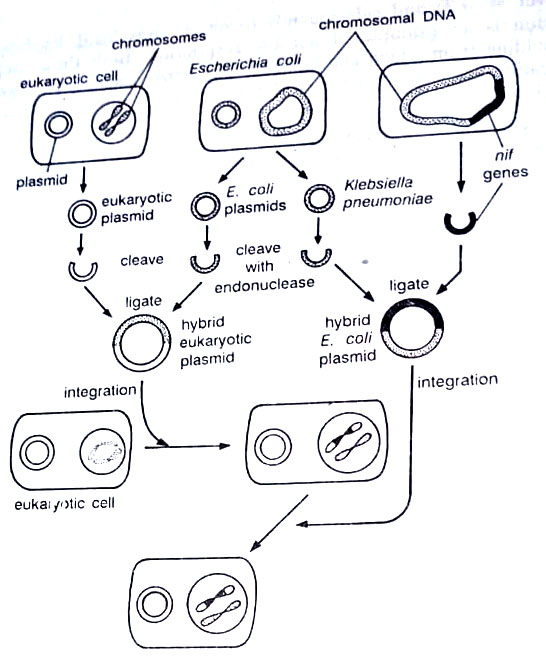
In the next step, the genes that are to be introduced into the yeast are isolated from the chromosome of Klebsiella pneumonia, a nitrogen-fixer. The genes, collectively designated nif. code for some 17 proteins. Another E. coli plasmid is cleaved, and the isolated nif genes are introduced to form a second hybrid plasmid. (BSc 2nd Year Microbiology of Soil Notes Study Material)
Because of the bacterial DNA already inserted into one of the yeast chromosomes, the yeast cell recognises the hybrid E. coli plasmid. The plasmid is then integrated into the yeast chromosome. Though it could be demonstrated that the transfer of genes between prokaryotes and eukaryotes (here yeast) could be possible, the N2-fixing proteins are not expressed in the yeast. M studies are being done on the expression of nif genes into eukaryotic cells. (BSc 2nd Year Microbiology of Soil Notes Study Material)
Sulphur cycle
Sulphur can exist in a variety of oxidation states within organic and inorganic compounds. Each oxid-red reaction, mediated by microbes, changes the oxidation states of sulphur within various compounds, establishing the sulphur cycle.

Microbes are able to remove sulphur from organic compounds. Under aerobic conditions, the removal of sulphur results in the formation of sulphate, whereas under anaerobic conditions H2S is produced from the mineralisation of organic sulphur compounds. H2S may also be formed by sulphate-reducing bacteria. H2S can react with metals to form insoluble sulphides. In organic-rich soils, most of the H2S is generated from the decomposition of organic sulphur compounds. (BSc 2nd Year Microbiology of Soil Notes Study Material)
In anaerobic sulphate-rich marine sediments, H2S is generated by sulphate-reducers like Desulfovibrio.
H2S is utilised by Beggiatoa and Thiothrix, which generate ATP by oxidising it. But these are heterotrophs and require organic carbon for growth. However, species of Thiobacillus are autotrophs (chemolithotrophs) which are found in acidic habitats and oxidise H2S. The ATP thus generated is used for the fixation of CO2. (BSc 2nd Year Microbiology of Soil Notes Study Material)
Other cycles
Microbes are also involved in the cycling of other elements such as H, O, and P as well as Fe, Mn, Ca, etc. through their respective cycles. The hydrogen and oxygen cycles in the biosphere are closely tied to the carbon cycle.
Rhizosphere
The role of microbes in the biological cycling of nutrients should evident in another important area of microbial ecology – the interactions between diverse microbial populations. There are interactions not between microbes but also between microbes and higher organisms – i.e. plants and animals. Various types of such associations have been considered in a separate chapter earlier. The diverse types of interactions, recognised in nature include neutralism, commensalism, protocooperation, mutualism competition, amensalism, parasitism and predation. These have already been considered in detail. Precisely, we could see how the two populations are affected in each of these associations, as shown below.

In soil, most of such interactions operate between different microbes and between them and plants as well as animal populations. Such interactions are important in plant growth. This is in the root region that some of the interactions, particularly synergism (protocooperation) and competition are very important in the biology of root pathogens. (BSc 2nd Year Microbiology of Soil Notes Study Material)
The rhizosphere is the zone of soil in the immediate vicinity of plant roots, characterised by intense microbial activity. Synergistic interactions between plants and microbes are important in providing the nutritional requirements of both. Within the rhizosphere, the plant roots exert a direct influence on the soil bacteria, known as the rhizosphere effect.
Likewise, the microbial populations in the rhizosphere have a pronounced effect on the growth of the plant. As a result of these interactions, there is a qualitative effect and microbial populations reach much higher densities in the rhizosphere than in the free (non-rhizosphere) soil. There is also a quantitative effect. Short Gram-negative rods predominate in the rhizosphere, while Gram-positive rods and coccoid forms are less numerous in the rhizosphere than elsewhere in soil. (BSc 2nd Year Microbiology of Soil Notes Study Material)
The interactions of plant roots and rhizosphere microbes are based largely on interactive modifications of the soil chemical environment by processes such as water uptake by the plant; release of organic chemicals in soil by roots; microbial production of plant growth factors; and microbially mediated availability of mineral nutrients. (BSc 2nd Year Microbiology of Soil Notes Study Material)
Within the rhizosphere, the bacteria obtain required growth factors, such as sugars, vitamins and amino acids from the plant roots. In turn, rhizosphere microbes have a marked influence on the growth of plants. (BSc 2nd Year Microbiology of Soil Notes Study Material)
Microbial populations in the rhizosphere benefit the plant by (i) removing H2S, which is toxic to roots. (ii) increasing solubilisation of mineral nutrients, (iii) synthesizing vitamins, amino acids, auxins, and gibberellins that stimulate plant growth and (iv) antagonising potential root pathogens through competition and antibiosis. Allelopathic substances produced by some microbes, may not allow the invasion of that habitat by other plants, thus help rendered by rhizosphere microbes to their host plants.
BSc 2nd Year Microbiology of Soil Notes Study Material
BSc 2nd Year Sample Model Practice Mock Test Question Answer Papers